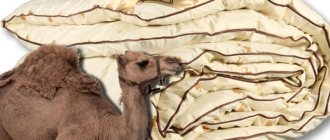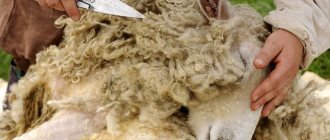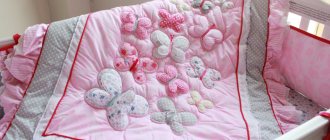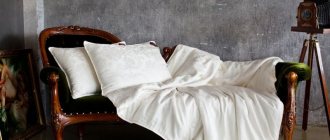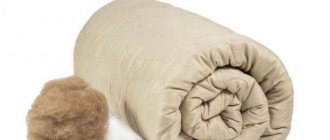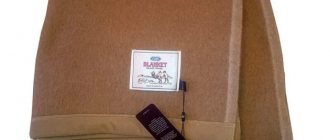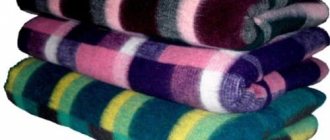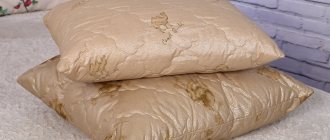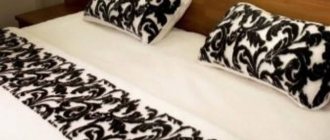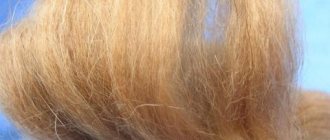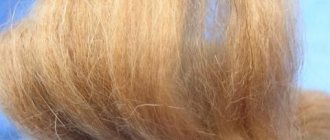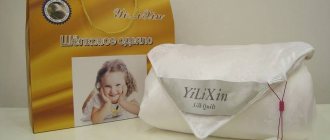Fiber production process
For blankets, the wool of Bactrians (Bactrian camels) and dromedary camels, which have one hump, is used. Animals are shaved and fibers combed out during molting (undercoat or fluff) are used. Depending on the breed and age, the hairs range in thickness from 6 to 120 microns. The structure of camel hair is similar to that of fine-fleeced Merino sheep, only lighter.
Camels have the best hair. The natural color of the hairs varies from cream to brown. There are animals of beige and brown color.
The raw materials are sorted, washed, dried, and combed. They try to leave wool in its natural form, rarely dye it, practically do not subject it to additional processing, and try to preserve the advantages of environmentally friendly natural raw materials. Used as filler or for making threads, they are used to create camel jacquard blankets on looms.
For reference . Camel down is especially valuable, it is soft and light, and is used for children's blankets.
Advantages and disadvantages
First, the good stuff. Camel wool is two times lighter than sheep's wool, the products are warm and light, and the weight of the blankets is light. The hairs act on the principle of a thermos: they retain natural heat, preventing overheating. Because of these advantages, blankets are often made from raw materials for children of different ages.
Lanolin is preserved in the fibers - an animal wax that preserves the ability of wool to self-clean. The products are practical.
Camel hair rarely causes allergies in people and is safe for people with sensitive skin. Felted items retain their shape for a long time, have good vapor permeability, and “breathe.” When the fibers are used as filling for quilts, they do not wrinkle and remain fluffy.
Of the minuses it is worth noting:
- poor palette of wool shades;
- high cost of models;
- demanding care;
- possible insect damage.
Note! When choosing bedding, it is worth considering climatic conditions. When air humidity is often high, wool suffocates, it is necessary to frequently dry the products in the sun.
The filler does not wrinkle under load and remains loose for many years.
Review of children's sizes
When considering the issue of buying a blanket for a child, requirements such as the highest quality, unpretentiousness and safety immediately come to the fore. Price, in the question of how to choose a camel wool blanket for a child, plays the last role.
Manufacturers have made the task easier when choosing; they provide several sizes. Parents just have to consider the best option that suits the parameters of their baby and his crib. Size ranges available on the market: 110 × 140 cm, 100 × 150 cm, 100 × 140 cm, 100 × 135 cm.
Children's products are hypoallergenic, do not cause irritation, do not collect dust, are lightweight and do not shed. Manufacturers try to make their products as comfortable as possible for the most demanding of their consumers.
Not sure what the best camel hair blanket is? How to choose? Are you also interested in the price? In this article you will find answers to all your questions!
Varieties
Manufacturers offer a variety of natural and mixed products. When choosing, they are guided by several criteria; when purchasing a woven blanket, the density of the weave is assessed. Quilters learn:
- volume of filler (layer thickness), the warming ability depends on this;
- fiber composition, sometimes synthetics or plant fiber are added to wool to reduce cost
- material used for the cover;
- a method of fixing insulation in a product.
Quilts are made with wide machine stitch and pattern stitch. The disadvantage of stitched options is that the hairs penetrate into the holes made by the sewing needle. Cassette packings are considered the most practical. Take into account the density of the products (g/cm2):
- 420 – the warmest blankets;
- 300…350 – all-season, universal, used in spring, autumn, winter;
- 220…280 – for the off-season, warm houses, these are lightweight models;
- 200...220 - the lightest options, reminiscent of quilted bedspreads.
For children, it is advisable to purchase blankets made from camel down, as they have the lightest weight.
Open wool
Those who love lint are offered products that look like a fur blanket. Delicate fabric made from the down of camels and baby camels is particularly soft and comfortable. Such blankets are chosen to decorate the interior of country houses with wooden trim.
Closed wool
Many people prefer quilted options, where the wool is hidden in a fabric cover. A closed blanket is much more practical; these are traditional models for which you use the hair of adult animals.
A quilt is a classic option for a child's room. The child will be warm and comfortable.
Choosing a manufacturer
Do you want to buy a camel wool blanket? We will tell you how to choose a manufacturer right now!
There are several leading manufacturers: foreign (imported) brands and domestic ones.
The most famous foreign blankets are “GOBI”, produced in Mongolia. The products are 100% natural, the products contain only the wool of Mongolian camels without any impurities. Due to this, the brand is known all over the world, and is considered one of the best options in terms of quality and price.
AlViTek is a factory located near Moscow that produces quilts from camel down and wool, both warm and lightweight. One of the collections is also called “GOBI”, so when purchasing this type you need to carefully look at where it was produced.
“Aelita” - quilts, thickened, regular and lightweight in cotton covers, produced in the city of brides and textiles - Ivanovo.
The Trinity Worsted Factory produces woven blankets. Their most famous products are: “Sahara” (made from camel down) and “Karakum” (camel wool).
“Fleece” - another famous Russian one, is a rug of natural colors, which is undoubtedly a sign of quality.
“Dargez” is a production line of stitched blankets made of camel wool and down, presented in two collections: children’s “Camel” and adults’ “Sahara”.
"Lezheboka" produces quilts from the wool of Mongolian camels.
“Tailak” is a brand of all-season blankets of good quality with decorative elements and constant healing properties.
Dimensions
Children's and adult blankets are available in various formats. The width of modifications for children ranges from a meter to 1.1 m, length from 135 to 150 in increments of 5 cm. 110x140 is the most popular size.
For adults they do:
- one-and-a-half blankets in the following formats: 140x200, 145x205 (the most popular size, in constant demand), 150x210, 155x220;
- double: 172x205 (according to the old domestic standard), 175x205 (modern analogue);
- double standard “euro” or “king size” format 200x220 cm.
Sometimes there are sizes 180x210, it is difficult to choose a duvet cover for them.
Price
When choosing camel wool bedspreads, it is the price, oddly enough, that is an excellent measure of quality. This is explained by the fact that high-quality wool itself is not cheap, and fluff is even more expensive.
Of course, there is a range of prices, as with all types of goods, but we can say for sure that if the price tag for an adult blanket or blanket costs 1,500 rubles, then you can pass by. This product is either counterfeit, or of poor quality, or with a large percentage of impurities of other, cheaper, types of raw materials.
The pricing policy for choosing blankets is as follows:
- Children's sizes are available from 1,500 rubles;
- from 4000-7000 rubles, all-season, one-and-a-half-size wool blankets from domestic manufacturers are presented;
- from 10,000 rubles the same blanket, only made in Mongolia;
- from 11,000 rubles, products made from camel down are offered, which already belong to the elite category.
And if you still don’t know how to choose a camel wool blanket, customer reviews will help you.
Types of fabrics for quilted covers
By looking at the stitch, you are supposed to find out what kind of fabric was used. Pros and cons of covers made of various fabrics:
- cotton or silk satin shines, is pleasant to the touch, wear-resistant, can withstand up to 300 washes;
- Cotton or linen teak comes in twill (compacted) and linen (simple) weaving and is inferior to satin in practicality and appearance;
- cambric is distinguished by its delicacy and softness, and is often used for summer blankets;
- percale is made from glued threads, is characterized by high strength, low hygroscopicity, recommended for winter, the appearance of the material is matte, smooth to the touch;
- calico is the most economical type of cotton, a thin fabric on which pills will form without a duvet cover;
- twill (keeper) - a coarse fabric of twill weaving with a small rib, used for winter options.
The cover does not play a special role, since the blankets must be tucked into the duvet cover.
Important! For high-quality models, bias tape is sewn along the edge of the cover, which reliably fixes the filling and fabric, preserving the shape of the product.
This is an open type camel blanket. In a warm cocoon on cool days it is cozy and warm.
Selection tips: important characteristics
The main selection criteria: format, thickness and composition of the filler. The warming ability of products depends on the last two indicators. It is also worth considering the density of the cover and the quality of the stitching. The degree of density depends on the method of fixing the filler; in large volumes, wool can clump.
Note! The heat index is usually indicated by dots from one to five; the more dots, the warmer the proposed modification.
Reviews
Many who have purchased a camel wool blanket for themselves or a child agree that this purchase is one of the best. Compared to other products, it takes up less space, is more comfortable and warm, is easy to care for, and is also not devoid of aesthetic beauty.
Let us once again recall the main criteria that will help you figure out how to choose a blanket made of camel wool.
- Pay attention to the price, it cannot be low.
- Down is more expensive and of higher quality than wool.
- The higher the density, the warmer the product.
- The fabric should be uniform and the fibers should not be knocked out. When trying to pull out a few hairs, you need to make a lot of effort.
- And finally, the material for the cover should be pleasant and durable.
In this article we have discussed more than one camel wool blanket. How to choose, review, disadvantages and advantages were also presented in this article. Good luck!
The best manufacturers
The best products are made in Mongolia, they are known as “camel”, and animals are always depicted on blankets with quilting. Products from Kazakhstan and Germany are valued. A popular domestic company is Alvitek, which produces “Sahara” blankets made from camel wool for various seasons.
In the rating of consumer preferences are the products of the companies Spalenka, Kariguz, Verossa, Togas, Aelita, Dargez, Ecotex, NeSaDen, Lucy, Asika, Light Dreams, Sovinson and others.
Basic recommendations
In order for the bedspread to serve for many years and not lose its basic properties, it should be selected according to several basic criteria.
Blankets that are comfortable in all respects are made from the wool of young camels; their cover is closest to down. Good materials.
Touching the product will also tell you about good quality: if the blanket does not ripple and has a uniform fabric, this indicates its high class. The edge processing should be smooth. The cover (if provided) can only be made from natural materials, and most importantly, be suitable for long-term use.
The density of camel blankets varies from 200 g/m² to 420 g/m². Here everything depends on the period for which it is purchased. Accordingly, a denser product is designed for a colder season.
Don't know how to choose a camel wool blanket? We will help you with this! If you look at how blankets are made, you can divide them into 2 types.
- Closed wool. This type includes products made from the wool of more mature camels. To prevent the blanket from prickling, a certain manufacturing technology is used, which is why they are called quilted. The principle is this: the wool core is stitched between the two halves of the cover.
- Open wool. “Young” wool is already used here and the product itself is more reminiscent of a soft and beautiful blanket than a blanket.
Blankets are also divided into lightweight and regular. Here the main criterion is the density of the product. Heavier, warmer and, accordingly, dense products are classified as ordinary blankets. While blankets can be called lightweight. They have a more interesting design, they are lighter and are designed for the off-season; you can simply cover yourself with them in the evening while lying on the sofa.
How to wash
There are situations when the blanket requires major cleaning. You can do it at home. Housewives have learned to wash items made from camel wool in two ways.
Manually
It is recommended to use laundry soap or gels for wool fabrics so that the fibers become less tangled. Water temperature is +30°C; hot water will destroy natural lanolin. You should not wring out the blanket; change the water until all the soap solution has been rinsed out. Then the product is allowed to drain well, after which it is dried as usual.
Pros of original camel blankets
Camel wool in a quilted or woven blanket determines the unique properties of the product:
- Warm and not hot. Such blankets are a great option for couples where one is always cold and the other is hot. The natural filler maintains a person’s body temperature, and if the person becomes hot and sweats, the wool absorbs this excess moisture. In camel wool, this property is especially pronounced due to the high lanolin content in the hairs. It is this substance that allows the material to take moisture from the air without getting wet.
- Durability. This blanket will also serve your grandchildren, unless you intentionally ruin it by washing it in the machine with powder.
- No static electricity. With modern processing, the canvas does not accumulate charge.
Do not be afraid of the difficulties in caring for natural products made from camel hair. The main thing is to follow the recommendations given by the manufacturer. And these are just two main points:
- ventilate the product every few months;
- use dry clean or hand wash (check the instructions on the product tag), dry, carefully placing on a horizontal surface.
